As the regulator of the profession in Ontario entrusted with protecting the public interest, the Ontario Association of Architects’ (OAA) Headquarters (HQ) Renew + Refresh renovation demonstrates first-hand how existing buildings can be successfully adapted to minimize environmental impacts and support a sustainable future.
The retrofit of this low-rise office building paid special attention to both operating energy (the energy needed to run buildings) and embodied energy (the sum impact of all greenhouse gas emissions attributed to a material during its life cycle) to ensure the building’s life cycle performance would be environmentally sustainable. A number of products and systems were chosen to optimize the building’s performance and improve the interior environment for OAA members and staff using the space for meetings and events. However, despite numerous upgrades, it was crucial to respect the original structure, which opened in 1992 and was designed by Toronto-architect Ruth Cawker, winner of a province-wide design competition.
When the OAA Headquarters passed its 25-year mark, extensive building-maintenance needs and above-average energy-use costs prompted serious questions about the value of retaining the building and OAA Council considered numerous possible options and outcomes, from selling to demolition to renovation.
After careful review, Council learned replacing outdated systems with current energy-efficient ones was a financially viable option that would achieve an impressive target of zero operating carbon use; the result—led by architect David Fujiwara—is a highly energy-efficient building fully powered by renewable energy sources rather than those that create carbon dioxide emissions.
Given the current climate crisis, buildings need to last more than a few decades; they have to be adapted, modernized, and improved over time. As a general policy, the OAA has committed to the 2030 Challenge, an initiative spearheaded by U.S. architect Ed Mazria, which aims to take the building sector to zero carbon emissions by setting gradually reducing performance targets for all new buildings and major renovations. By 2030, the target will be 100 per cent reduction.
The OAA Headquarters is situated in the Don Mills area of Toronto, located along the Don River Valley, a greenspace artery that cuts through the city. On a small parcel of land donated by Crang + Boake Architects in the 1980s, the original design of the building has the offices and meeting spaces raised on pilotis—reminiscent of Le Corbusier’s Villa Savoye – maximizing views of the natural surroundings and creating the experience of soaring over the landscape. As one critic, Marie-Paule Macdonald, said of the building shortly after its opening in 1992, “it tuned into its location near typical factory lots in Don Mills, an area that was once light industrial and has been transforming into offices. It adapts to its context by making its own strong, individualist statement, albeit more rigorous and formally daring than the norm.”
The OAA is currently in the early stages of a Landscape Design Competition to revitalize the property surrounding the building. The competition emphasizes sustainability and sensitivity to the land on which the headquarters are located.

Building Orientation and Layout
The OAA Headquarters is oriented such that its striking glass façade is angled towards Moatfield Drive, meaning it benefits from the southeastern sunlight, while the northern side of the building remains unglazed.
Ruth Cawker describes her design intentions as “organized around a simple, central space, [while] white-painted steel structural elements are discreetly present at all the spatial boundaries without appearing overly muscular or intrusive. The most important aspect of the major central space is attended to: the suffusing of pure daylight through the glassed-in slots between the roof and upper walls is true architectural manipulation of space, the building's greatest asset.”
David Fujiwara and the team paid careful attention to retaining this original vision, pushing it further in the retrofit by removing closed office spaces in favour of open concept, which improves air circulation and promotes thermal comfort. Those closed meeting spaces that do exist on the third floor and in the southeastern corner are encased in glass, to preserve a feeling of lightness. The design also introduced dynamic and flexible spaces, maximizing their use and thus their efficiency. The central space was transformed from an underutilized reception area to an eatery, event/lecture space, informal gathering area, and more.
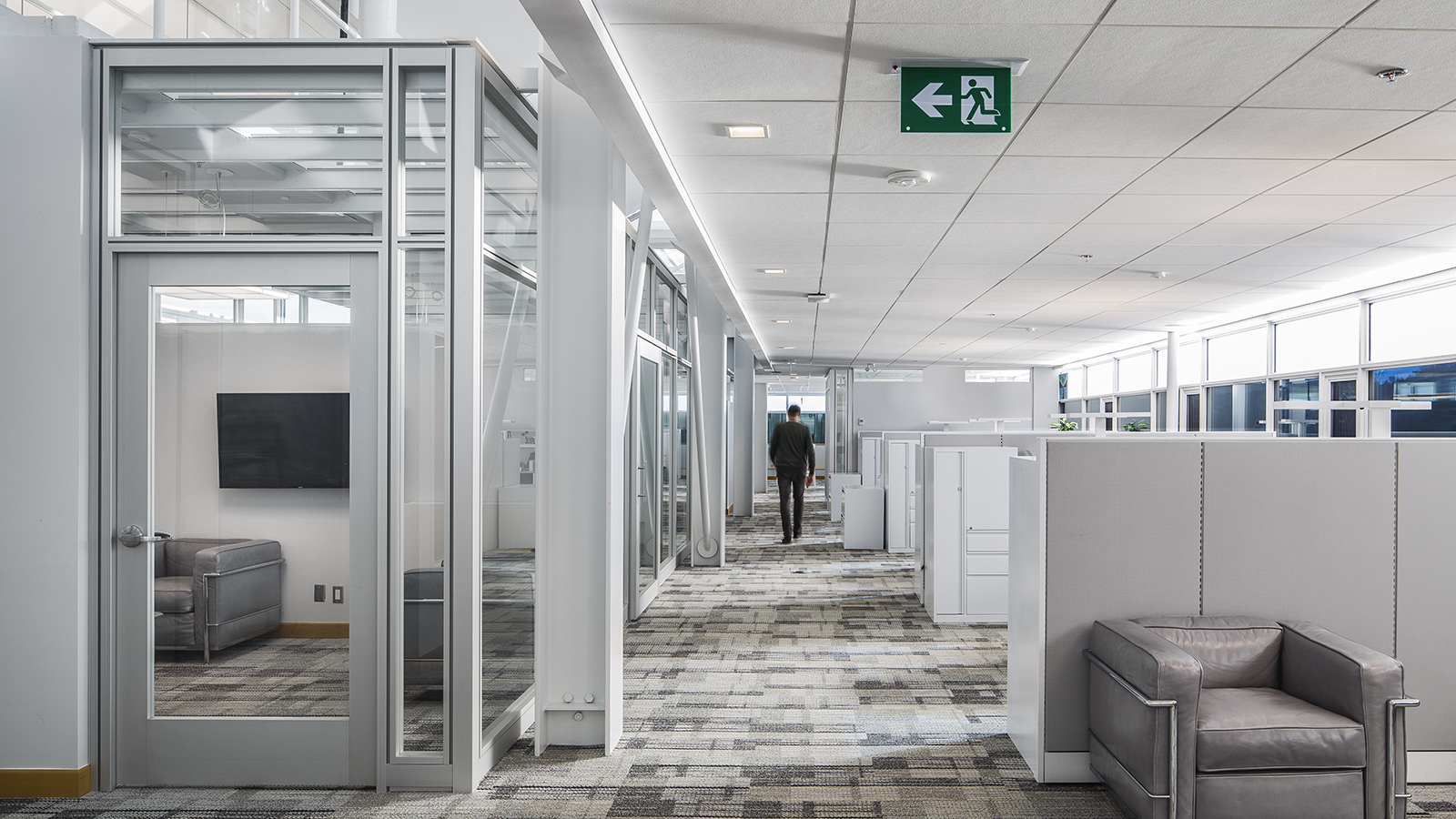
Light/Air
As described above, one of the building’s greatest assets is its abundance of natural light, introduced in the original design and maximized in the open concept renovation design. Third floor offices are wrapped in windows that face all directions save north, with all work stations benefitting from generous daylight.
However, a lighting strategy was necessary to reduce discomfort caused by excessive sunlight, a project led by Gottesman Associates. The current lighting approach still leverages natural light and indirect lighting strategies that bounce light off surfaces, with highly efficient LED overhead lighting used sparingly in meeting rooms, washrooms, and along central pathways. Lights are occupant-activated, responding accordingly as users enter and exit spaces, to minimize wasted energy. Electrochromic glazing was also installed which darkens as daylight increases beyond comfortable levels, reducing glare and thermal gain (and subsequently reducing load on cooling systems).
The building also now uses a fresh air circulation system, abandoning recirculated air, and a large ceiling fan located in the central area circulates air with great efficiency—made that much more efficient by the open concept layout.
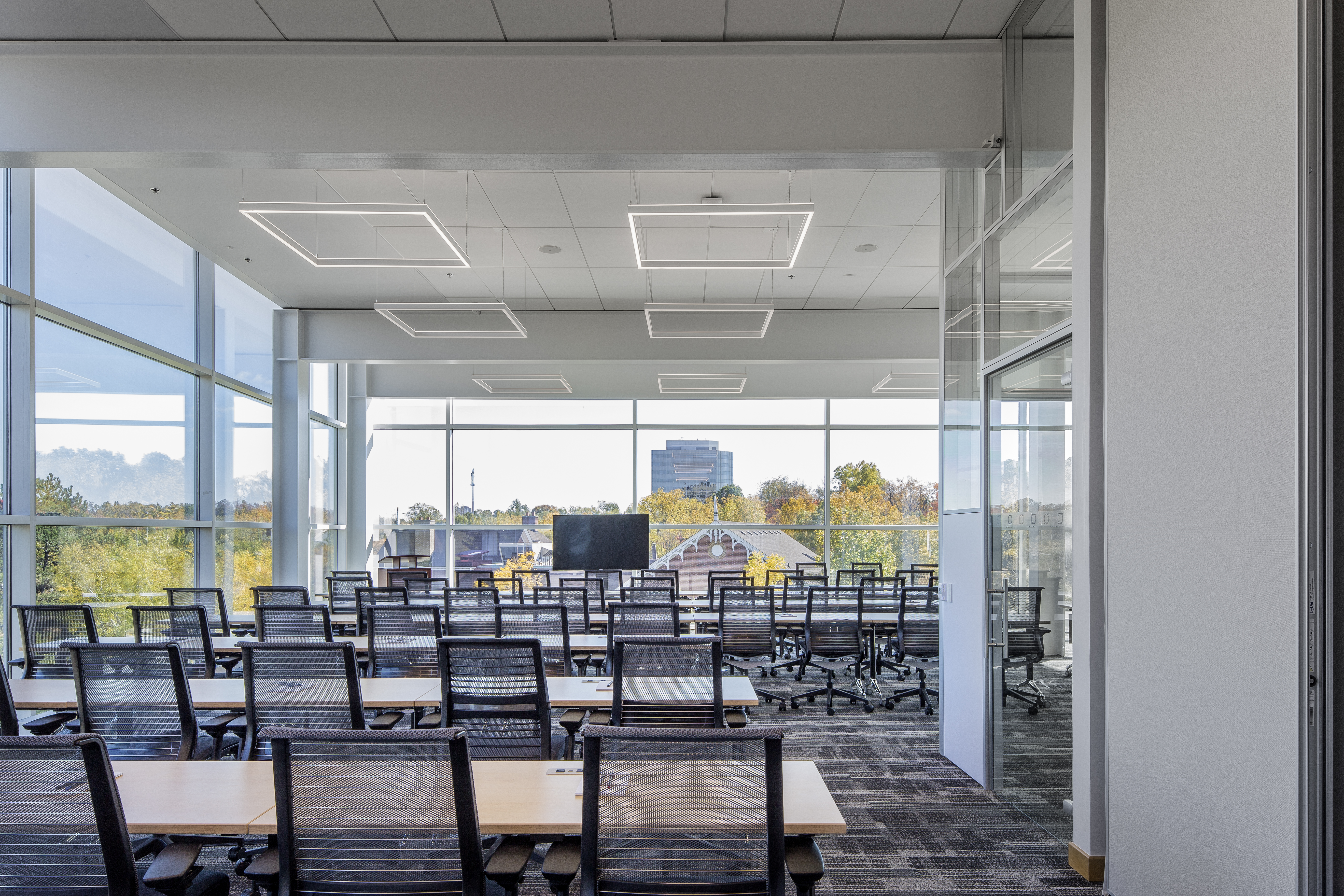
Water
Due to limitations on the relatively small site and existing building design, existing rain water drain systems were not changed during renovations. The lawn portion of the site manages rainwater, accounting for approximately 30 per cent of the lot’s surface area.
Within the building, water conservation measures are taken in washrooms, with all new toilets installed, two low-flush and nine ultra efficient. The ultra high efficiency toilets use an innovative flushing system and are only 3 litre/flush, well below the Ontario Building Code standard which requires 6 litre/flush.
Furthermore, hot water is partially heated using solar energy whenever possible and otherwise relies on an electric heater, rather than natural gas

Energy
Ruth Cawker’s original design of the OAA Headquarters was built to the R2000 standard, which was better than the norm in the 1990s—a fact validated by its initial airtightness test. With a roof structure that anticipated the addition of solar panels, the OAA prioritized sustainable energy options throughout the life of the building.
Both operating energy and embodied energy guided decision-making during renovations. New photovoltaics and solar panels are among the many active and passive technology upgrades now offsetting the building’s energy use with energy creation, ultimately offering “free” electricity and hot water. A number of products and systems optimize performance and improve the interior environment for users. These include high-efficiency occupancy lighting, displacement ventilation, replacing traditional gas boiler HVAC for geothermal heating pumps (supported with radiators and fan coil units), enhanced insulation (triple-glazed panes, fiberglass window framing, and highly insulated soffit), and View dynamic glass that changes its tint level with the sun.
The transition to all-electric has reduced the building’s emissions an impressive 97% and annual energy use dropped 91%, translating to an annual energy cost reduction of 85%!
Moving forward, the building operations will continue to be monitored and fine-tuned to ensure the OAA HQ remains on target for maintaining zero net carbon.
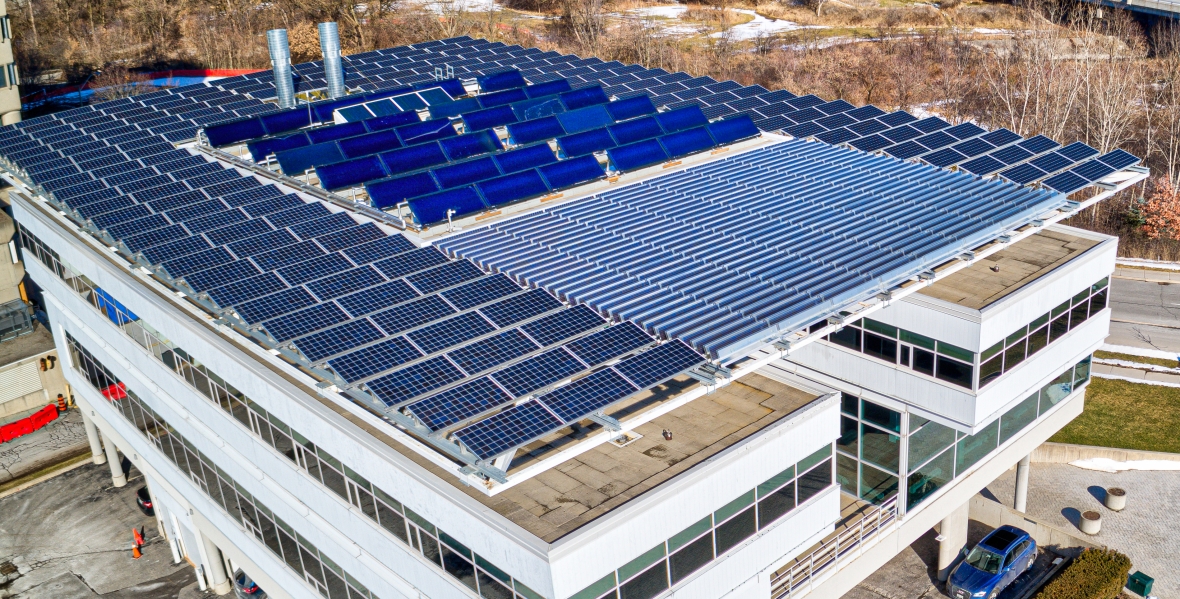
Materials + Construction
The major benefit to retrofit projects is that many of the materials required are already in place, which is often the most sustainable option as it preserves embodied energy. For the OAA renovation, it was agreed that the building structure would be retained in order to preserve Ruth Cawker’s original vision; only the interior was transformed.
The exterior of the building remains much the same, however windows throughout were replaced with energy efficient triple-pane glass with electrochromic View Dynamic Glass which tints its colour in response to the strength of the sunlight. While the original aluminum window framing was kept, locally made fiberglass frames were installed on top to improve insulation.
Most materials were locally sourced (less than 100 km), and a number of finishes comprise post-consumer recycled content including the carpeting, ceiling tiles, and staff work station furnishings. Wherever possible, existing furnishings were refinished and reupholstered to extend their life.
For any demolition that did occur, all waste—including drywall, insulation, metal studs, wood studs, copper cable, copper pipe, and other metal pipes—was diverted, while a portion of construction waste was also diverted.
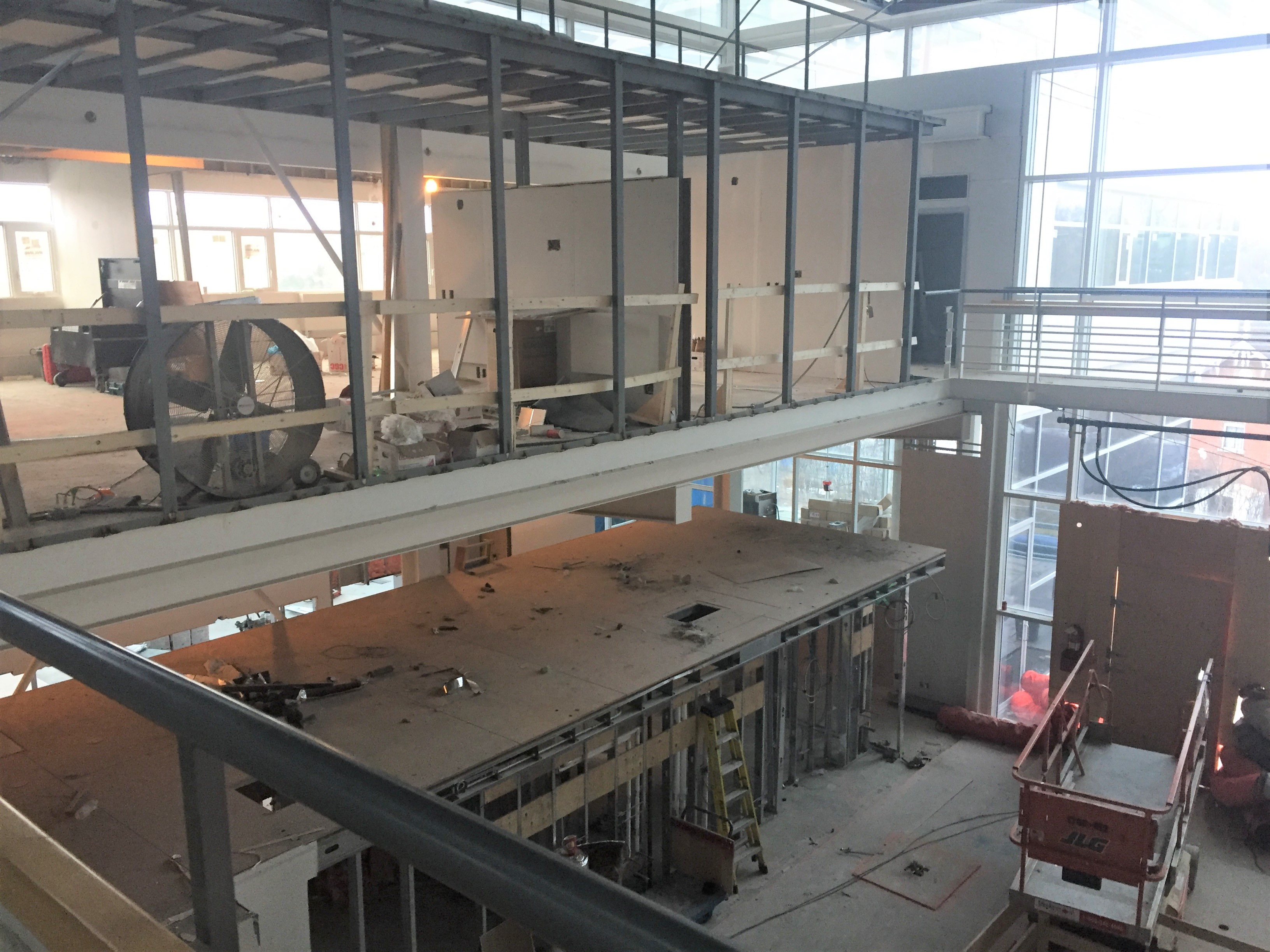
Life/Adaptability
The now thirty-year-old OAA Headquarters has had new life breathed into it, upgrading and updating systems and finishes to extend its use and lifespan so that it continues to serve member, Council, and staff needs for the next several decades.
Due to the pandemic, OAA HQ was largely underused after renovations were complete. However, with people once again frequenting the building, the important work of monitoring and maintenance is underway, with fine-tuning occurring as it undergoes typical use and wear and tear.
A few projects remain on the horizon, including the eventual replacement of the on-site elevator, and the much larger and exciting work of landscaping the property through a design competition, set to be launched in early 2023.

Community
With a new interior layout, the OAA HQ has doubled in capacity, effectively getting twice as much out of the carbon it was consuming.
Having steadily grown over the last 25 years, the Association now supports more than XX member committees, all dedicated to protecting the public, improving practice, promoting design excellence, and increasing awareness of the profession. Its membership includes over 4400 architects and more than 130 Licensed Technologists OAA, while also supporting others on the path to licensure.
The layout of the building needed to evolve to optimize the use of space. Through the renovation, the capacity for employees and the number of meeting rooms were doubled. Additionally, state-of-the-art technology was brought in to better host web-based meetings and foster distance collaboration, and layout flexibility was included so spaces could expand or contract to host events.
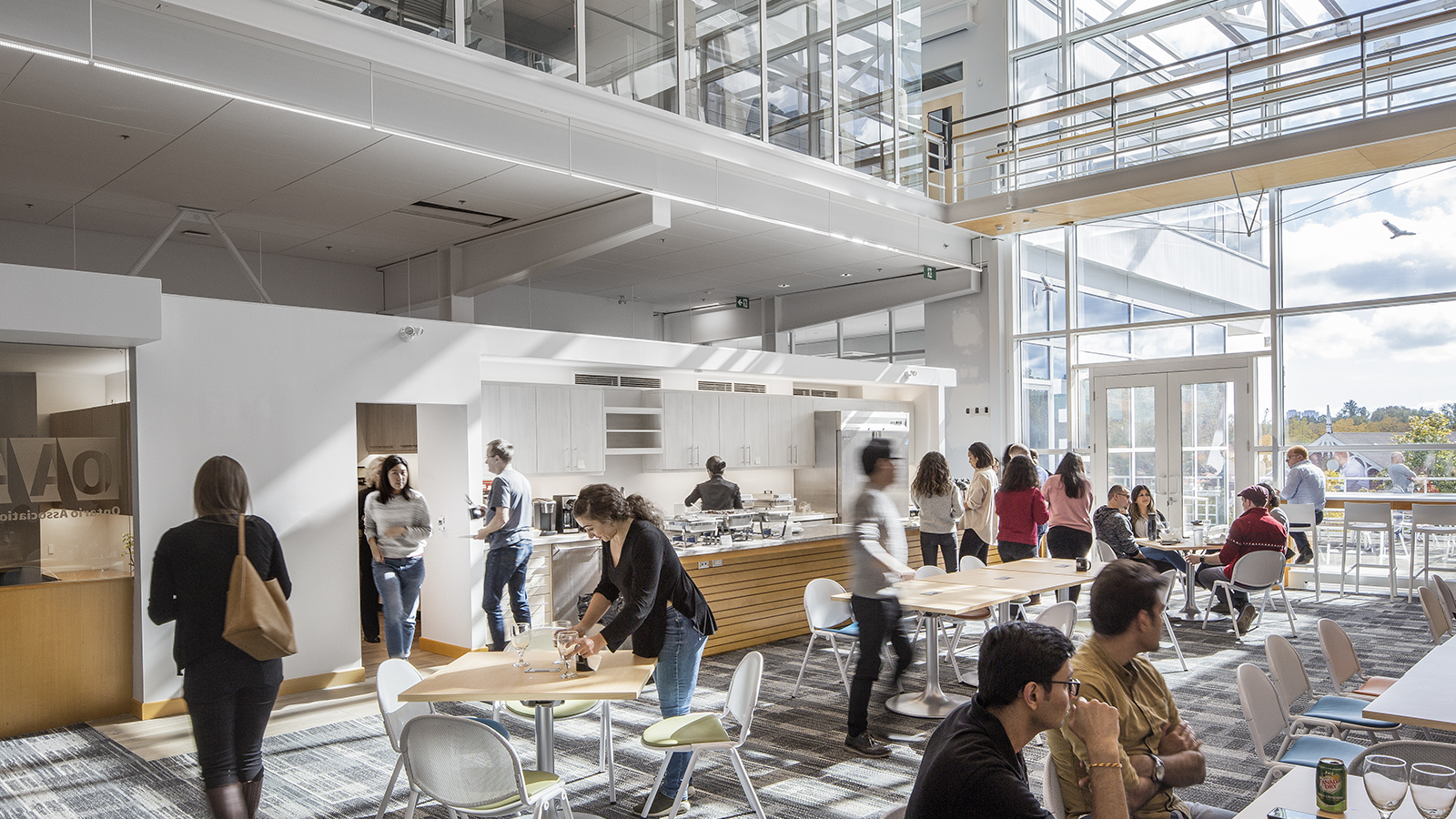
Project Team
• Original Architect: Ruth Cawker
• Architect of Renovation: David Fujiwara Architect
• Contractor: MJ Dixon Construction Ltd.
• Mechanical: WSP Canada Inc.
• Electrical: WSP Canada Inc.
• Structural: Peter Sheffield & Associates Ltd.
• Lighting Consultant: Gottesman and Associates
• Quantity Surveyor: Turner Townsend
• Furnishings Consultant: Eve Marshall Interior Design
• CFD Modelling: WSP Canada Inc., EH Price Industries, Prof. Michel Bernier/École Polytechnic, Transsolar KlimaEngineering
• Civil: Planmac Engineering Inc.
• Design Challenge: National Research Council Canada and
Greg Allen, P.Eng.
• Commissioning: WSP Canada Inc.
• Partner: Energy Assessment + Support: National Research Council Canada (NRC)
Past and Present OAA Building Committee Members
• Chair: Sheena Sharp (2015 – 2022)
• Bill Birdsell (2015)
• Toon Dreessen (2015 – 2017; 2018 – 2019)
• Gord Erskine (2018 – 2021)
• Kathleen Kurtin (2015; 2018 – 2021)
• Lara McKendrick (2022)
• Deo Paquette (2021)
• John Stephenson (2015 – 2019)
• Andrew Thomson (2020 – 2022)
• Ted Wilson (2022)
![]()